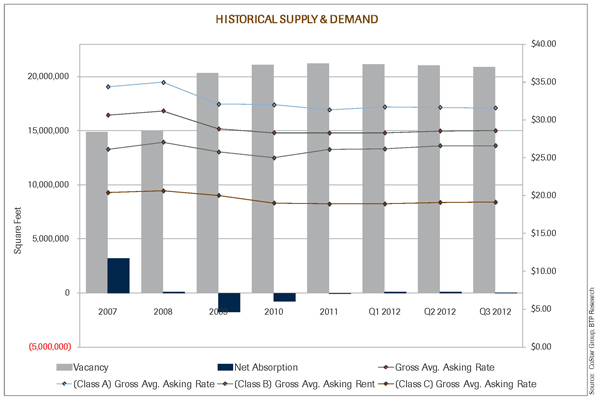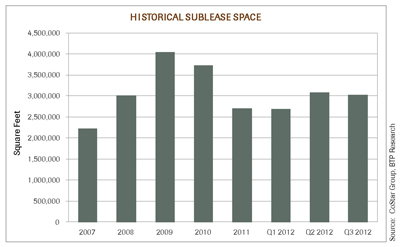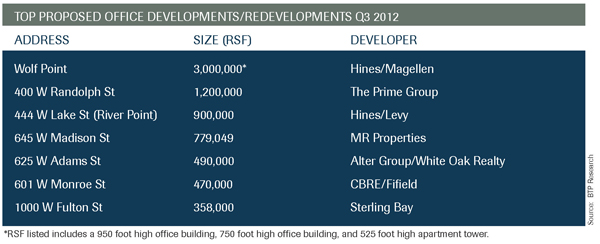-
-
recent posts
archives
- July 2015
- December 2013
- November 2013
- August 2013
- April 2013
- February 2013
- December 2012
- November 2012
- October 2012
- August 2012
- June 2012
- May 2012
- January 2012
- November 2011
- October 2011
- June 2011
- May 2011
- April 2011
- March 2011
- June 2010
- March 2010
- February 2010
- December 2009
- November 2009
- October 2009
- April 2009
- August 2008
categories
- Capital Markets
- Commercial Real Estate
- Completed Transactions
- Economic Recovery
- Innovation
- Landlord Financial Issues
- Lease Renewals
- Loan Delinquencies
- Macro Economy
- Market Statistics
- Misc.
- Never Be Defeated
- New Lease
- Press
- SQUARE FEET
- Sublease
- Sustainability
- Tenant Representation
- Uncategorized
- Workplace Strategy
-
CHICAGO MARKET OUTLOOK Q3 2012
Signs of Life Continue
Chicago’s economy – along with the downtown office leasing market – continue to show signs of life.

Important indicators, like unemployment, vacancies, absorption, and rental rates, continued to improve this quarter. We’ve seen demand from historically suburban-based
companies like Sara Lee, Google and others, relocating downtown. And, we’ve seen increased demand from technology companies as Chicago focuses on building jobs in this sector.
The Chicago Economy
Chicago’s unemployment rate fell to 9.4% at the end of Q3 2012, the lowest rate since 2008. This may be a hopeful sign for the Chicago economy, but it is still well above the state and national average.
Though we’ve seen some improvement in the Nonfarm Payrolls prints over the last few months, there are not enough jobs to sustain a strong recovery, and therefore, a strong landlord market. A significant proportion of those jobs, however, are in occupations whose growth bodes well for the CBD real estate market. One analysis shows that as much as 17% of available jobs are in information technology fields, with 13% in management, 10% in office and administrative support, and 8% in business and financial. With job gains distributed among these fields, even small increases will result in increased demand for downtown office space.

Chicago’s volatile 2009 – 2012 job market has made employers cautious in making real estate commitments. Unemployment data are notoriously opaque, and there is rarely consensus about the exact reasons behind changes in the unemployment rate. Variations in the city’s labor force participation rate, for example, along with the extension of unemployment benefits, can affect the unemployment rate in non-intuitive ways. The recovery continues to grind along slowly and is expected to be drawn out over many years.
Demand rises slightly in Chicago’s central business district
Small changes continue in CBD real estate indicators: direct vacancies are down slightly (to 15.1%) and rents are up slightly (to $28.57), showing that the market is starting to see modest increases in demand. The drop in vacancies is due to a number of factors: some employers are hiring or rehiring, some are hanging onto leases in anticipation of being able to return to a pre-recession workforce, and some are entering the CBD real estate market for the first time, relocating from suburban markets.
Absorption, which is the difference between the amount of space leased and taken off the market and the amount put back on the market, paints a similar picture. Class B absorption is highest at 78,760 rentable square feet. This is followed by Class C and then Class A, both of which had negative absorption for the quarter. Despite this, overall absorption was positive in Q3 2012 at 54,188 RSF. In fact, it has been positive for the first three quarters of 2012. The CBD has been stuck in a negative annual net absorption trend since 2009, but we expect this trend to reverse by year end.The changes in demand stand out much more clearly within each of the three divisions of downtown real estate. The mid-level, Class B (space that’s good, but not spectacular) is in slightly greater demand, with a 14.5% vacancy rate this quarter, followed by the prime real estate in Class A with 14.8%. In contrast, Class C space demand (the lowest-rung) is weak at 19.0%. All three classes have seen vacancy decline from last quarter. The River North submarket has the lowest vacancy rate at 9.2%.

Rental rates for the quarter largely correspond to vacancies and absorption, with a couple of variations. Class B space, particularly in River North, is in the highest demand. With this, the average Class B rates have climbed slightly to $26.59. Meanwhile, Class A space has seen a small reduction in average asking rates as the rate dropped to $31.58 from $31.65 last quarter. This may correlate to the negative absorption reported among Class A space for the quarter. Rates have increased slightly in Class C space to $19.12 (this reflects the low rents in many Class C properties, which in many cases can’t be further reduced). Class B rates continue to inch closer to Class A rents. In fact, as of this quarter, they’re closer than they’ve been for the last 7 years – which may inspire some Class B tenants to make a leap up to Class A. For a price differential that’s at a historic low, they would achieve a sizable upgrade in their surroundings.
 Sublease Space
Sublease Space
Overall, Q3 2012 shows a modest decrease in space available for sublease. As economic prospects improve, employers feel less need to cut internal expenses by subleasing out their space. In a weak landlord market, sublease space competes with direct space making disposition difficult even for quality space. As a result, some companies will forgo subleasing if they have a short amount of lease term left. Also, when their lease expires, they may no longer need as much space per employee due to alternative workplace strategies and increased employee density metrics. Everyone is trying to make do with less and the second place employers looks for efficiency is in the amount of space they occupy.
New Developments
There are several proposed office developments for downtown Chicago. Some of these may secure an anchor tenant over the next year, but competition for prime space will remain tight. During Q4 2012, Hines is expected to break ground on their proposed 45-story office tower at 444 W Lake that is to be completed by 2016. Wolf Point is being built on spec (meaning they do not yet have an anchor tenant). Several large tenants are already contemplating relocating. So, the game of musical chairs will continue. A redevelopment by Sterling Bay Partners is underway for the Fulton Cold Market Storage at 1000 W Fulton St. The warehouse is being converted to loft-style office space that is currently in high demand among the tech sector. In fact, they have already secured a 77,000 user – SRAM – to occupy the building once done. Overall, the CBD is starting to see a constraint in the amount of large blocks of space that are available, making a move by the big boys difficult and competitive.
Who’s Moving the Market?
Motorola Mobility (recently acquired by Google) led the market this quarter with its announcement to move its headquarters and 3,000+ jobs from suburban Libertyville to the top four floors of the Merchandise Mart. In fact, Google will receive nearly $55.8 million from the Merchandise Mart’s owner to cover the upfront expenses of moving its Motorola Mobility division, according to a Securities and Exchange Commission filing by the building’s owner, Vornado Realty Trust. That works out to $97.50 per RSF for Motorola Mobility to build out its new River North space.
United Continental Holdings expanded its presence at the iconic Willis Tower to a total of 830,000 square feet. It will soon occupy 25% of the building. Draft FBC followed suit with United in consolidating its employees from 2 locations in another iconic Chicago building – the John Hancock. By and large, technology companies led the way with business services and transportation companies a short lag behind.
Where Is the Opportunity?
It continues to be a good time for tenants looking for office space in the Chicago Business District. Rents are lower, overall, than pre-downturn levels and landlords are still offering generous concessions to lure creditworthy tenants. Class A space rents are closer to Class B prices than they have been for several years. This provides opportunity for companies currently occupying Class B or C space to significantly upgrade their aesthetic without breaking their budgets. Small to mid-sized companies, particularly, have broad space options downtown. If they are creditworthy, they have the upper hand in negotiating favorable rates and concessions with landlords.
As more companies flock downtown to attract young talent, landlords are anticipated to become more bullish in 2013. In fact, we have already seen many of them pushing back on rents and concessions in our recent negotiations. Now is the time. Get in while rates are low.



